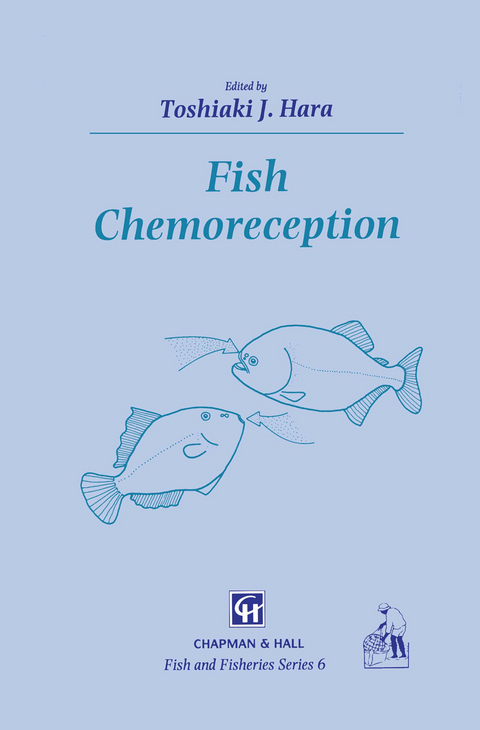
Fish Chemoreception
Chapman and Hall (Verlag)
978-0-412-35140-2 (ISBN)
This book describes in general how the chemosensory systems of fish function at various levels. In many ways, fish are typical vertebrates differing only slightly from other vertebrates including humans. In other ways, their aquatic environment imposes strict requirements or offers unique opportunities which have resulted in some unusual functions having no counterpart in higher vertebrates. This new volume is necessitated by advances in many vital areas as the field of chemical senses continues to grow at a rapid pace. Most significant is the application of the contemporary electrophysiological technique of patch-clamping, recognition of a second messenger system in chemosensory transduction processes and the identification of hormonal pheromones in fish reproductive behaviour. The last major synthesis of our knowledge about fish chemoreception, Chemoreception in Fishes, was published ten years ago (Elsevier, Amsterdam, 1982). In that volume four aspects of fish chemoreception, Le. morphology of the peripheral chemoreceptors. primary sensory processes, roles in behaviour, and its interactions with environment, were discussed. This book is intended to be helpful to students, scientists and aquacul turists not only as a source book but also as a textbook on chemical senses.
1 Overview and introduction.- 1.1 Chemical stimuli in the aquatic environment.- 1.2 Characteristic features of fish chemosensory organs.- 1.3 Signal transduction and transmission.- 1.4 Receptor sensitivity and specificity.- 1.5 Chemoreception in behavior.- 1.6 Chemoreception and water pollution.- 1.7 Conclusion.- References.- 2 Structure, development, and evolutionary aspects of the peripheral olfactory system.- 2.1 Introduction.- 2.2 Gross morphology.- 2.3 Histology.- 2.4 Development.- 2.5 Adaptation and evolution.- 2.6 Summary and conclusion.- Acknowledgement.- References.- 3 Synaptic organization of the olfactory bulb and its central projection.- 3.1 Introduction.- 3.2 Olfactory bulb.- 3.3 Telencephalic hemisphere and secondary olfactory areas.- Acknowledgements.- Abbreviations.- References.- 4 Structure of the peripheral gustatory organ, represented by the siluroid fish Plotosus lineatus (Thunberg).- 4.1 Introduction.- 4.2 Distribution and gross anatomy of taste buds.- 4.3 Fine structure of taste buds.- 4.4 Discussion.- Acknowledgements.- Abbreviations.- References.- 5 Central representation and projections of gustatory systems.- 5.1 Introduction.- 5.2 Primary gustatory centres.- 5.3 Medullary networks and descending gustatory projections.- 5.4 Supramedullary gustatory pathways.- 5.5 Summary.- Acknowledgement.- Abbreviations.- References.- Solitary chemosensory cells.- 6.1 Introduction.- 6.2 Distribution.- 6.3 Cytology.- 6.4 Innervation.- 6.5 Physiology.- 6.6 The common chemical sense.- 6.7 Paraneurones.- 6.8 Conclusion.- Acknowledgements.- References.- 7 Molecular mechanisms of chemosensory transduction: gustation and olfaction.- 7.1 Introduction.- 7.2 Receptor events in chemoreception.- 7.3 Receptor-mediated chemosensory transduction.- 7.4 Conclusion.- Acknowledgements.- References.- 8 Mechanisms of olfaction.- 8.1 Introduction.- 8.2 Sensory transduction.- 8.3 Signal transmission.- 8.4 Sensitivity and specificity.- 8.5 Neural coding.- 8.6 Summary and conclusion.- Acknowledgements.- References.- 9 Teleost gestation.- 9.1 Introduction.- 9.2 Historical background of gustatory peripheral nerve physiology.- 9.3 Response features for simple chemical compounds.- 9.4 Receptor site types for amino acids.- 9.5 Taste responses of single facial taste fibres.- 9.6 Enhanced taste activity.- 9.7 Behaviour to chemical stimuli.- 9.8 Tactile sensitivity of peripheral neurons.- 9.9 Summary.- Acknowledgements.- References.- 10 Hormones, pheromones and chemoreception.- 10.1 Introduction.- 10.2 History of the definition of pheromone.- 10.3 Origins of the hypothesis that fish use hormonal sex pheromones.- 10.4 Current status of the hypothesis and future considerations.- 10.5 Neural responsiveness to sex pheromones.- 10.6 General conclusions.- Acknowledgements.- References.- 11 Kin recognition in fish mediated by chemical cues.- 11.1 Introduction.- 11.2 Salmonids.- 11.3 Studies of nonsalmonid fishes.- Acknowledgement.- References.- 12 Olfactory control of homingbehaviour in salmonids.- 12.1 Introduction.- 12.2 Ecological framework.- 12.3 Olfaction and homing behavior.- 12.4 Olfactory hypotheses in salmonid homing.- 12.5 Possible mechanisms of olfactory control.- 12.6 A model system and its ecological implications.- 12.7 Summary and conclusions.- References.- 13 Gustation and nutrition in fishes: application to aquaculture.- 13.1 Introduction.- 13.2 Identification of feeding stimulants.- 13.3 Relevance of feeding stimulants to nutrition and feeding.- 13.4 Dietary application of feeding stimulants.- 13.5 Feeding stimulant effects on nutrition.- 13.6 Conclusions and prospects.- Acknowledgements.- References.- 14 Food search behaviour in fish and the use of chemical lures in commercial and sports fishing.- 14.1 Introduction.- 14.2 Food search behavior.- 14.3 Modifiers of food search.- 14.4 Effectiveness of natural materials as food search inducers.- 14.5 Chemical nature of food search inducers.- 14.6 Chemical lures.- Acknowledgements.- References.- 15 Environmental contaminants and chemoreception in fishes.- 15.1 Introduction.- 15.2 Histological effects of contaminants.- 15.3 Physiological and biochemical effects of contaminants.- 15.4 Behavioural responses to contaminants.- 15.5 Future research.- Ackowledgements.- References.- Author index.- Species index.
Some important new information on receptors is presented...This book is a good mix of detailed information on physiology and anatomy linked with information on behaviour, ecology and aquaculture. A wide range of readers from comparative anatomists to fishery managers will find it a useful addition to their libraries - Journal of Fish Biology
| Erscheint lt. Verlag | 31.7.1992 |
|---|---|
| Reihe/Serie | Fish & Fisheries Series ; 6 |
| Zusatzinfo | XIV, 373 p. |
| Verlagsort | London |
| Sprache | englisch |
| Maße | 155 x 235 mm |
| Themenwelt | Naturwissenschaften ► Biologie ► Ökologie / Naturschutz |
| Naturwissenschaften ► Biologie ► Zoologie | |
| Weitere Fachgebiete ► Land- / Forstwirtschaft / Fischerei | |
| ISBN-10 | 0-412-35140-4 / 0412351404 |
| ISBN-13 | 978-0-412-35140-2 / 9780412351402 |
| Zustand | Neuware |
| Haben Sie eine Frage zum Produkt? |
aus dem Bereich


